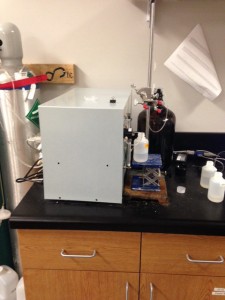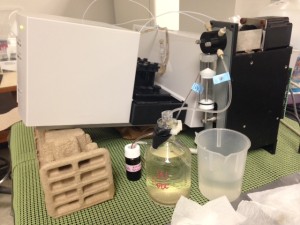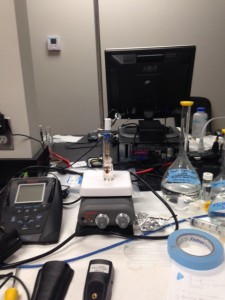I participated in research about how inorganic carbon flows in the ocean and South Texas estuaries in Dr. Hu’s lab while working with his research assistant Cory Staryk. The research in this lab is to learn more about the Inorganic Carbon Cycle in the Gulf of Mexico and the estuaries in South Texas. I accompanied Cory on a NERR (National Estuarine Research Reserve) research trip to collect water samples. He then allowed me to work on almost all of the machines he uses to collect data from the water samples. He uses this data to find pH, DIC, carbon, alkalinity, and salinity in the samples we collected for the partial pressure of carbon dioxide. They use this information to track the carbonate chemistry of the system over many years. They hope to use this information to understand how the system works and how it will work when it becomes unbalanced.
Who We Are
What We Did
The first thing that we did was I went on a research trip from the UT Marine Institute in Port Aransas using a research boat and collected samples from five different locations in different Estuaries. The Estuaries we collected the samples from was Copano Bay, Mesquite Bay, Aransas Pass, and off the ship channel in Port Aransas. During this trip we collected samples from the bottom of the water using a Van Dorn then collected water from the top at each location. I mostly collected samples from the top, though I did use the Van Dorn at the most shallow location. It was very heavy to lift full of water.
The next phase of this research we were in the lab and had to use different machines to see different properties of the water.
The first machine that needed to be used is called a DIC Analyzer and it measures the amounts of Dissolved Inorganic Carbon. This machine had to be used first because we had to be sure that air wouldn’t mix with the water, especially the water from depth. I was never able to actually use this machine because it was very particular on how it should be run.
The next step is to find the pH of the water. For this two methods are used to ensure accuracy. The first machine is called a spectrophotometer. This machine has to have the water samples at a certain temperature. It has little hoses that go into the water sample jar and into a tube to a cylinder that has a light on one end. It is hooked to a laptop where after running the sample it gives information that Cory uses to find pH and partial pressure of carbon dioxide. The other method uses a pH electrode, this method is more reliable when dealing with lower salinity levels. I would get data from the spectrophotometer first then give the sample to Cory so he could use the pH electrode.
Other tests that we ran on the water samples tested alkalinity and calcium using titrators. The Calcium Titrator was difficult because I was never able to get three numbers from the test that were similar enough with the known water to move on to the samples we collected. Cory uses this information to measure the amount calcium flowing into the Estuary system from rivers and bays. I never used the Alkalinity Titrator but they would use this machine next in their research.
The last test they would run would be the Salinometer. It measures the salinity of the water. For this test I had to carefully clean the arm between each test to make sure the readings were correct. I would record the salinity it reported and the temperature of each water sample into a notebook. Compared to the other machines this one was rather simple and less particular about the temperature and amount of air in the water.
All of this information is going towards having a better understanding of the Inorganic Carbon Cycle in the Gulf of Mexico and South Texas Estuaries. This information will help with our understanding of how carbon and acidification will impact our oceans.
What We Learned
The Estuaries in Texas are not as stable as the ocean.
How to get samples from the top of the water and from depth.
This information will help with understanding what happens to the system when it changes.
Research machines are very picky and you have to make sure that everything is perfect in order for them to work.
Questions We Have
How can we prevent acid and carbon levels from rising more?
What will be done with the new information from this research about the inorganic carbon cycle in the estuaries?
Has there been a noticeable change in carbon and acid levels in the Gulf of Mexico and the Estuaries?
How does ocean acidification and increased carbon affect the wildlife? How does it affect us?
Connections to Teaching
(b) Knowledge and skills.
(4) Scientific investigation and reasoning. The student knows how to use a variety of tools and safety equipment to conduct science inquiry. The student is expected to:
(A) use appropriate tools to collect, record, and analyze information, including lab journals/notebooks, beakers, meter sticks, graduated cylinders, anemometers, psychrometers, hot plates, test tubes, spring scales, balances, microscopes, thermometers, calculators, computers, spectroscopes, timing devices, and other equipment as needed to teach the curriculum; and
(11) Organisms and environments. The student knows that interdependence occurs among living systems and the environment and that human activities can affect these systems. The student is expected to:
(B) investigate how organisms and populations in an ecosystem depend on and may compete for biotic and abiotic factors such as quantity of light, water, range of temperatures, or soil composition;
(C) explore how short- and long-term environmental changes affect organisms and traits in subsequent populations; and
(D) recognize human dependence on ocean systems and explain how human activities such as runoff, artificial reefs, or use of resources have modified these systems.









